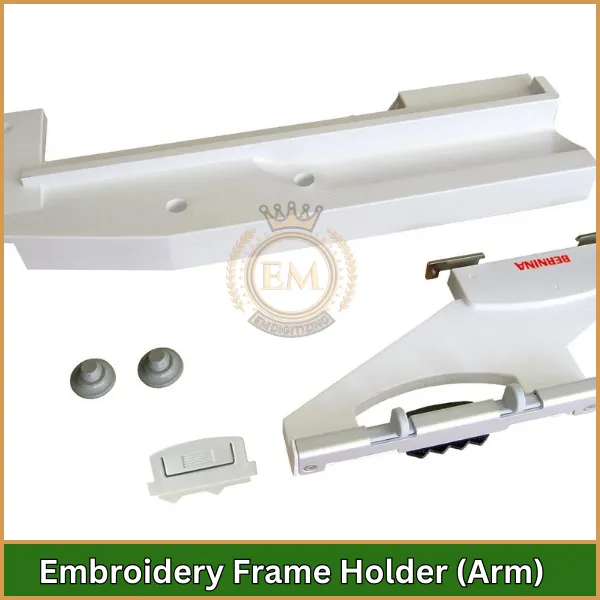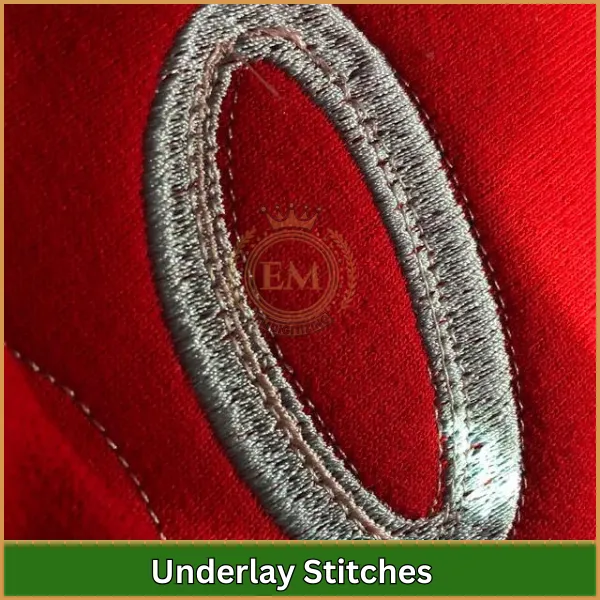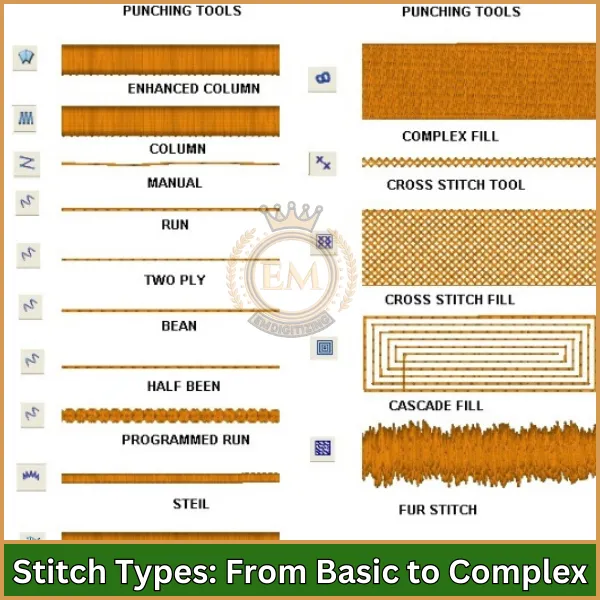If you’;re nuevo en el bordado, aprender términos de bordado a máquina es esencial para el éxito. Estos términos clave le ayudarán a utilizar su máquina y sus materiales correctamente.
En esta guía, desglosaremos los términos más importantes en un lenguaje sencillo, Haciéndole más fácil crear hermosos diseños con confianza..

Términos esenciales del bordado a máquina que debe conocer
Entendiendo su máquina de bordar
Para usar tu Maquina de bordar adecuadamente, Es importante conocer las partes principales y cómo funcionan juntas.. Esto hará que tus proyectos de bordado sean mucho más fáciles y exitosos..
Componentes clave de una máquina de bordar
Tu máquina de bordar tiene varias partes esenciales que le permiten crear diseños en tela.. Comprender estos términos de bordado a máquina lo ayudará a operar la máquina de manera eficiente y lograr mejores resultados..
Éstos son algunos de los componentes más importantes.:
Aro de bordado: Un marco que sujeta la tela firmemente durante la costura., asegurando un bordado suave y uniforme.
Aguja: La herramienta afilada que se mueve hacia arriba y hacia abajo para crear puntadas a través de la tela..

Bobina: Un pequeño carrete que proporciona el hilo inferior., trabajar con el hilo superior para formar puntadas.
Estabilizador: Un material colocado debajo de la tela para evitar que se estire o se arrugue durante el bordado..
Dial de tensión del hilo: Controla la tensión del hilo para garantizar una costura uniforme y suave..

Presilla: Mantiene la tela hacia abajo mientras se mueve a través de la máquina., permitiendo costuras precisas.
alimentar perros: Dientes de metal que mueven la tela hacia adelante durante la costura..
Placa de garganta: Una placa de metal con una abertura para que pase la aguja mientras se cose..
Barra de agujas: Sostiene la aguja y la mueve hacia arriba y hacia abajo durante el proceso de bordado..

Abrazadera de aguja: Asegura la aguja en su lugar, asegurando la estabilidad durante la costura.
Pasador de carrete: Sostiene el carrete de hilo, permitiendo que se desenrolle suavemente mientras la máquina cose.
Panel de control: La interfaz donde ajustas la configuración y seleccionas diseños para coser.

Soporte para bastidor de bordado (Brazo): Mueve el aro para seguir las coordenadas del patrón para una colocación precisa del diseño..
Cortador de hilo automático: Corta el hilo automáticamente después de coser o cambiar de color..
Recortadora de puntadas de salto: Recorta el exceso de hilo entre las secciones del diseño para mantener la parte posterior ordenada..
Mecanismo de cambio de color: Cambia automáticamente entre colores de hilo en máquinas multiaguja.
Cómo funciona una máquina de bordar
Las máquinas de bordar utilizan un sistema computarizado para coser diseños en tela.. Cargas un archivo de diseño en la máquina., colocar la tela en el aro, and the machine follows the design’;Instrucciones para crear el patrón con hilo..
Términos esenciales de los materiales de bordado a máquina
Entendiendo el derecho herramientas de bordado y los materiales son cruciales para lograr términos exitosos en el bordado a máquina.. Estas herramientas y materiales ayudan a garantizar que sus diseños queden impecables., preciso, y de aspecto profesional.
- Tela: El material base sobre el que se cose el diseño de bordado.. Diferentes tejidos, como el algodón, lino, o poliéster, reaccionar de manera diferente al bordado, Por eso, seleccionar el tejido adecuado es fundamental para obtener los mejores resultados..

2. Hilo de bordar: Un tipo especial de hilo utilizado en bordado a maquina términos.
Normalmente está hecho de rayón., poliéster, o algodón y está disponible en una variedad de colores para añadir vitalidad a tus diseños..
Los hilos de bordar están diseñados para ser fuertes y proporcionar una suavidad, acabado brillante.
- Estabilizador: Un material de respaldo que se coloca debajo o detrás de la tela para brindar soporte adicional durante el bordado.. Los estabilizadores evitan que la tela se estire., cambiando, o fruncir el ceño, asegurando que el diseño se cosa suavemente. Los tipos comunes incluyen desprendibles, recortado, y estabilizadores lavables.
- Aro: Un marco que sujeta firmemente la tela durante el proceso de bordado.. El aro consta de dos anillos.: un anillo interior y un anillo exterior, que sujetan la tela para mantenerla estable, asegurando costuras precisas.
- Aguja: Una herramienta afilada que se utiliza para coser el diseño en la tela.. Las agujas de bordar están diseñadas para manipular hilos y telas delicados sin causar daños.. Hay diferentes tamaños y tipos de agujas disponibles según la tela y la complejidad del diseño..

6. Interfaz: Un material utilizado para reforzar telas que pueden ser demasiado finas o delicadas para bordar..
Ayuda a estabilizar la tela y evitar la distorsión durante la costura..
La interfaz a menudo se fusiona con la tela mediante calor antes de comenzar el bordado..
- Estabilizador soluble en agua: Un tipo especial de estabilizador que se disuelve cuando se sumerge en agua.. A menudo se utiliza para encajes independientes o telas delicadas donde el estabilizador debería desaparecer una vez finalizado el bordado..
- Aerosol adhesivo temporal: Un spray utilizado para sujetar temporalmente la tela., estabilizador, o aplique en su lugar antes de coser. Ayuda a evitar el movimiento de la tela durante el proceso de bordado y es especialmente útil para telas complicadas..
- Tela de apliques: Un trozo de tela colocado encima de la tela base y cosido con puntadas de bordado.. Appliqué es una técnica en la que se cortan formas y se cosen en una pieza más grande para crear diseños., a menudo añadiendo textura y color a proyectos de bordado.
Conceptos básicos de digitalización para bordado
en el mundo de términos de bordado a máquina, La digitalización es un proceso esencial en el que los diseños se convierten a un formato que las máquinas de bordar puedan leer.. Estos son los términos clave utilizados en la digitalización, junto con sus definiciones.
Software de digitalización

Este es el software de computadora utilizado para crear o convertir un diseño en un archivo de bordado. Permite al usuario trazar rutas de puntada., seleccionar tipos de puntada, y ajustar la configuración para crear el diseño final que seguirá la máquina de bordar.
Digitalización automática
Una característica en software de digitalización que convierte automáticamente una imagen o gráfico en un diseño de puntada. Si bien esta es una opción más rápida, Es posible que no siempre produzca un diseño de la más alta calidad, ya que pueden ser necesarios ajustes manuales para detalles complejos..
Digitalización manual
Este es el proceso donde el usuario crea manualmente el diseño de bordado puntada por puntada. Ofrece control total sobre el diseño., permitiendo una mejor precisión, especialmente con patrones intrincados o detallados.
Formatos de archivos de bordado
Estos son los tipos de archivos específicos que lee una máquina de bordar para coser un diseño. Diferentes máquinas utilizan diferentes formatos.. Los formatos comunes incluyen:
- horario de verano (utilizado por muchas marcas, incluyendo máquinas industriales),
- PSA (utilizado por Brother y Babylock),
- JEF (utilizado por Janome),
- Exp (utilizado por Melco y Bernina).
Puntadas subyacentes

Estas son las primeras puntadas que se colocan en un diseño para estabilizar la tela y prepararla para la costura principal..
Las puntadas subyacentes suelen estar ocultas en el producto final, pero son fundamentales para proporcionar estructura y garantizar que el diseño mantenga su forma..
Compensación de empujar y tirar
Una configuración en el software de digitalización que compensa el movimiento o la distorsión de la tela durante el proceso de bordado.. Garantiza que las puntadas permanezcan alineadas con el diseño original a pesar de que la tela se mueva o tire durante la costura..
Rutas
El trazado se refiere a la secuencia en la que se colocan las puntadas durante el bordado.. La ruta adecuada minimiza los saltos o cortes de hilo innecesarios, hacer que la máquina funcione de manera más eficiente y producir resultados más limpios.
Densidad
La densidad se refiere a qué tan cerca se colocan las puntadas dentro de un diseño.. Ajustar la densidad puede afectar la apariencia., textura, y rigidez del diseño. Demasiada densidad puede endurecer la tela., mientras que muy poco puede provocar espacios o costuras sueltas..
Tipos de puntada: De lo básico a lo complejo

Diferentes tipos de puntadas crean diferentes efectos en tus diseños de bordado.. Estos son algunos de los puntos más comunes.:
- puntada corriente: Esta es una puntada simple que forma una línea recta y se usa a menudo para delinear diseños o agregar pequeños detalles..
- Puntada de satén: Las puntadas satinadas crean suavidad, áreas brillantes de hilo y son ideales para bordes, letras, o rellenar áreas pequeñas.
- Puntada de relleno (Puntada de tatami): Una puntada de relleno se utiliza para cubrir grandes áreas de un diseño con puntadas muy apretadas.. Agrega textura y llena las formas con color..
- Puntada en zig-zag: Una puntada que se mueve hacia adelante y hacia atrás en forma de zigzag.. Esta puntada se usa a menudo para bordes decorativos o para terminar los bordes de la tela..
- Punto de cruz: A stitch that forms an ‘;X’; forma en la tela. A menudo se usa en bordado a mano, pero se puede adaptar a términos de bordado a máquina para crear diseños complejos..
Términos de dominio del bordado a máquina: Técnicas Avanzadas
Aprender técnicas avanzadas puede ayudarte a llevar tus proyectos de bordado al siguiente nivel.. Aquí hay algunas técnicas clave para dominar.:
Puntadas en capas
La superposición de puntadas implica apilar diferentes tipos de puntadas una encima de la otra para crear profundidad y textura en su diseño.. Esta técnica añade un aspecto más profesional y dimensional a tu bordado..
Hilo degradado
Esta técnica utiliza hilo que cambia gradualmente de color., crear un efecto de desvanecimiento o fusión en el diseño. Es perfecto para añadir un toque dinámico y artístico a tu bordado..
3bordado

3El bordado D utiliza espuma u otros materiales colocados debajo de las puntadas para hacer que el diseño sobresalga de la tela., creando un efecto tridimensional elevado. Se usa comúnmente para logotipos llamativos o elementos decorativos..
En el aro (ITH) Proyectos
Los proyectos ITH se realizan íntegramente dentro del aro de bordado, lo que significa que puedes crear artículos completos como bolsas, juguetes, o posavasos sin quitar la tela del aro. Esta técnica combina costura y bordado a la vez.
Apliques
El aplique es una técnica en la que se colocan trozos de tela encima de la tela base y luego se cosen mediante bordado.. Permite diferentes texturas y colores., hacer que los diseños sean más vibrantes e interesantes.
Encaje independiente (FSL)

El encaje independiente implica la creación de diseños de encaje intrincados que pueden mantenerse solos sin una base de tela..
Esto se hace cosiendo un estabilizador soluble en agua., que se disuelve una vez completado el bordado, dejando solo el encaje atrás.
Conclusión
Aprender estos términos de bordado a máquina hará que usar su máquina de bordar sea más fácil y divertido. Conocer estos términos te ayudará a evitar errores y crear hermosos diseños de forma rápida y sencilla..
A EMdigitalización, podemos ayudarle a convertir sus ideas en diseños de bordado. Ofrecemos un servicio rápido, precios bajos, y trabajo de alta calidad para asegurar que sus diseños salgan perfectos.
Más, si es la primera vez que trabajas con nosotros, obtendrás 50% fuera de tu primer pedido! Déjanos ayudarte con la parte difícil para que puedas disfrutar haciendo tus proyectos de bordado..
preguntas frecuentes
Existen principalmente dos tipos de bordado a máquina.: bordado en movimiento libre y bordado computarizado. El movimiento libre se basa en el control manual, mientras que el bordado computarizado utiliza diseños preprogramados para costuras precisas.
Los seis puntos de bordado esenciales incluyen el punto corrido, pespunte, puntada de satén, puntada de tallo, nudo francés, y margarita perezosa. Estas puntadas forman la base para crear diversas texturas y patrones en el bordado..
Las mejores máquinas de bordar en 2024 incluir:
- Hermano SE600
- Hermano SE1900
- Bernette b79
- Artesanía de la memoria de Janome 14000
- Artesanía de la memoria de Janome 9850
El nudo de lingotes se considera uno de los puntos de bordado más difíciles.. Su intrincada apariencia de bobina exige precisión, ya que requiere enrollar el hilo alrededor de la aguja varias veces antes de pasarlo a través de la tela.
